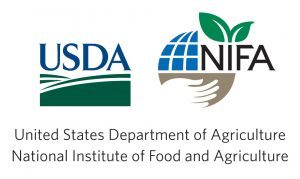Specialty Crops Research Initiative (SCRI)
 In 2010, the USDA’s National Institute of Food and Agriculture (NIFA) awarded $3.8M to improve drought and salinity tolerance for sustainable turfgrass production in the southern US to a team of breeders, extension specialists, agricultural economists, plant physiologists, and sociologists, from Texas A&M University (Dallas and Overton), University of Florida (Gainesville), University of Georgia (Tifton and Griffin), North Carolina State University (Raleigh), and Oklahoma State University (Stillwater). This coordinated effort fostered exchange of germplasm among these institutions and as a result each breeder shared promising experimental lines with other collaborating locations for evaluation under the wide range of environments that are present in the southern US.
In 2010, the USDA’s National Institute of Food and Agriculture (NIFA) awarded $3.8M to improve drought and salinity tolerance for sustainable turfgrass production in the southern US to a team of breeders, extension specialists, agricultural economists, plant physiologists, and sociologists, from Texas A&M University (Dallas and Overton), University of Florida (Gainesville), University of Georgia (Tifton and Griffin), North Carolina State University (Raleigh), and Oklahoma State University (Stillwater). This coordinated effort fostered exchange of germplasm among these institutions and as a result each breeder shared promising experimental lines with other collaborating locations for evaluation under the wide range of environments that are present in the southern US.
Out of 1,920 breeding lines that were evaluated in space-planted nurseries at seven locations (College Station and Dallas, TX; Stillwater, OK; Griffin and Tifton, GA; Jackson Springs, NC; and Gainesville, FL), 40 lines of each zoysia, bermuda, and St. Augustinegrass and 20 lines of seashore paspalum were selected for their superior performance under normal as well as drought conditions.
A second grant from NIFA in the amount of $4.3 M for this project was secured in 2015. This new phase of the project aimed at further evaluating the best materials selected during phase I for drought tolerance as well as wear, shade and herbicide tolerance, and sod production traits. An additional objective of the project was to improve the efficiency and effectiveness of selecting for drought and salinity tolerance by identifying DNA markers associated with these traits.
These prior projects have released two improved cultivars of bermudagrass (‘TifTuf’ and ‘Tahoma 31’), two for St. Augustinegrass (‘TamStar’ and ‘CitraBlue’) and two for zoysiagrass (FAES1319 and FAES1307). Furthermore, the Coordinated Agricultural Projects identified several molecular makers associated with drought and salt tolerance. Following further validation, these markers have potential to be used through marker-assisted selection to improve the efficiency of breeding selection.
A third grant was secured in 2019, where NIFA awarded $7.96 M. Beyond the genotype evaluations for biotic and abiotic stresses (for which a new testing location was included at the University of California, Riverside) and sod-tensile strength, and beyond identifying and validating the QTL associated with drought and salinity tolerance, this project aims to identify candidate genes through an integrated analysis combining gene expression with metabolic information. In addition, the project will quantify the water requirements of the group’s newly released water saving grasses in order to increase their adoption among consumers. The long-term adoption of new cultivars has the potential to transform many landscapes aligned with societal needs, providing functional landscapes that meet the demands of changing environments. The long-term adoption of these cultivars has the potential to transform many landscapes aligned with societal needs, providing functional landscapes that meet the demands of changing environments.
Evaluating emerging unmanned aerial systems (UAS) technologies for their potential to facilitate high-throughput phenotyping and improve data collection on drought tolerance associated traits will also be included as an objective in this grant. This will entail frequent flyovers by pilots stationed at each university to collect data on percent green cover, normalized difference vegetation index (NDVI), and visible atmospherically resistance index (VARI), three traits shown to be associated with drought tolerance. This objective will result in 1) optimization of a remote, multi-environmental phenotyping system through data analysis and validation using the diverse collection of germplasm amongst the universities and 2) successful use of UAS technologies to enhance turfgrass breeding and aid cultivar release.
The collaborative team believes that in the short-term this project will have a significant impact on the turfgrass industry as well as end-users (e.g. turfgrass managers, home-owners, etc.) through the conservation of water resources. Persistent turfgrasses that require less water result in cost savings through reduced irrigation, eliminating the need for replacement after prolonged droughts, and allow for greater sustainability and profitability for the turfgrass industry.
 This material is based upon work that is supported by the National Institute of Food and Agriculture, U.S. Department of Agriculture, under award number 2019-51181-30472. Any opinions, findings, conclusions, or recommendations expressed in this publication are those of the author(s) and do not necessarily reflect the view of the U.S. Department of Agriculture.
This material is based upon work that is supported by the National Institute of Food and Agriculture, U.S. Department of Agriculture, under award number 2019-51181-30472. Any opinions, findings, conclusions, or recommendations expressed in this publication are those of the author(s) and do not necessarily reflect the view of the U.S. Department of Agriculture.